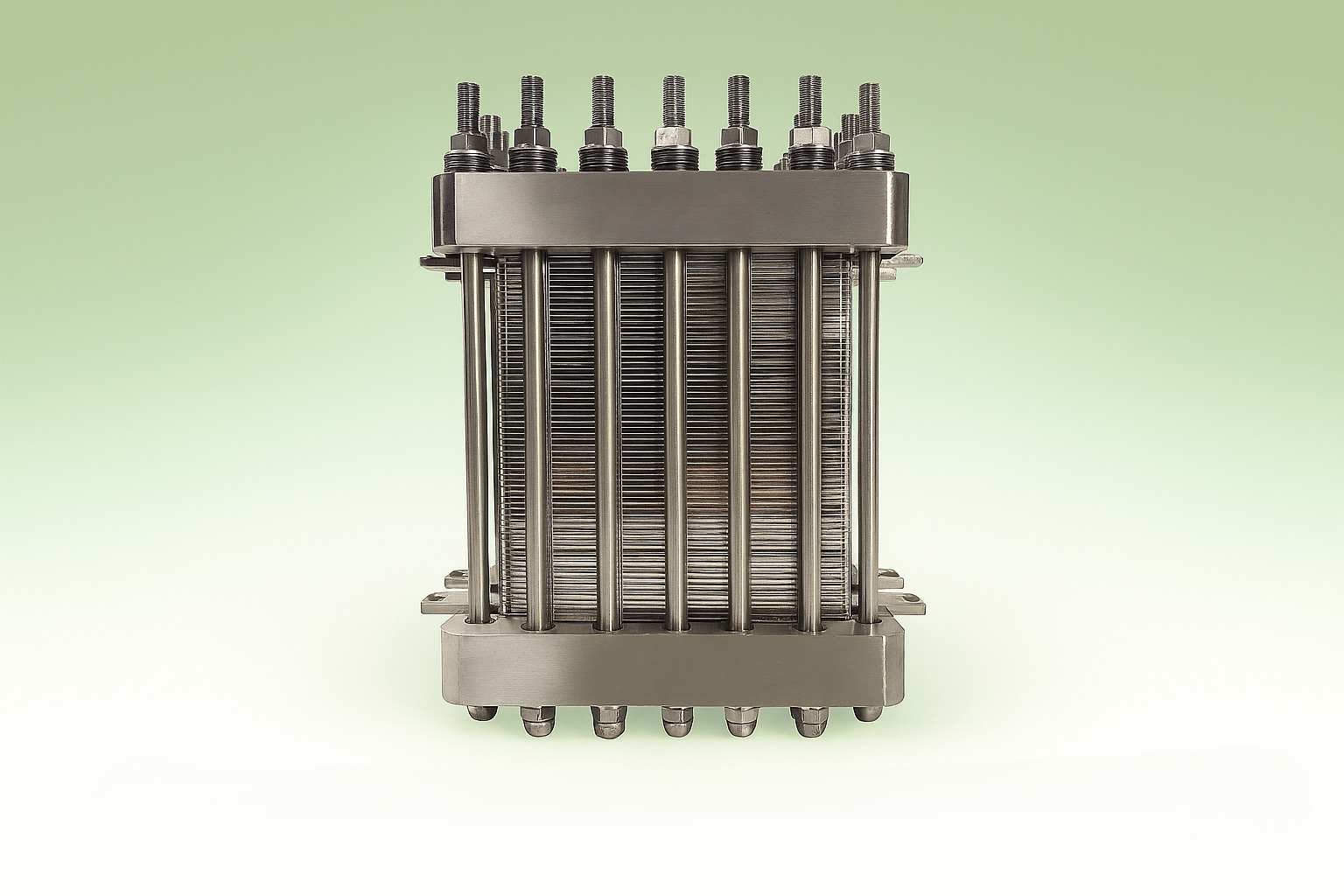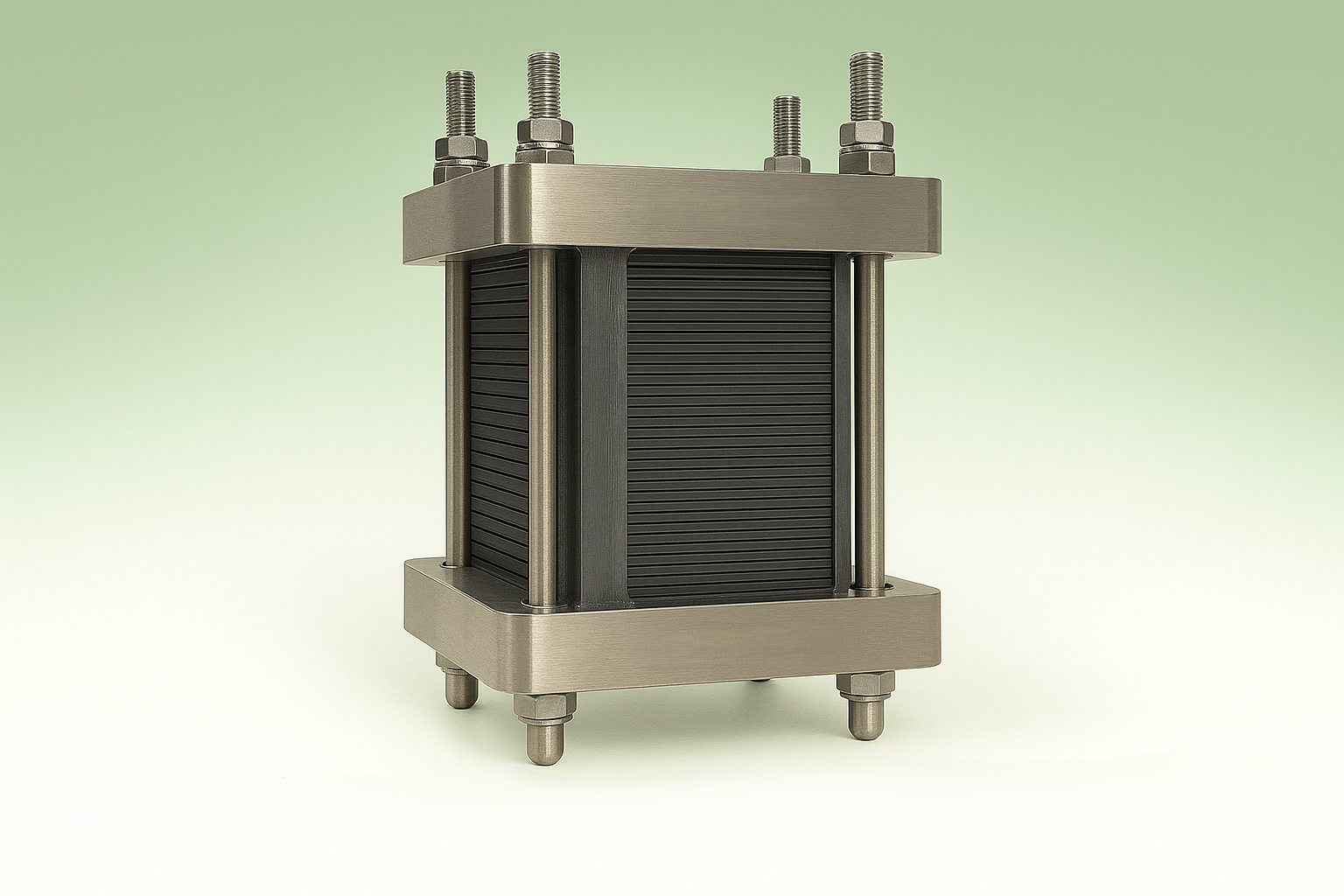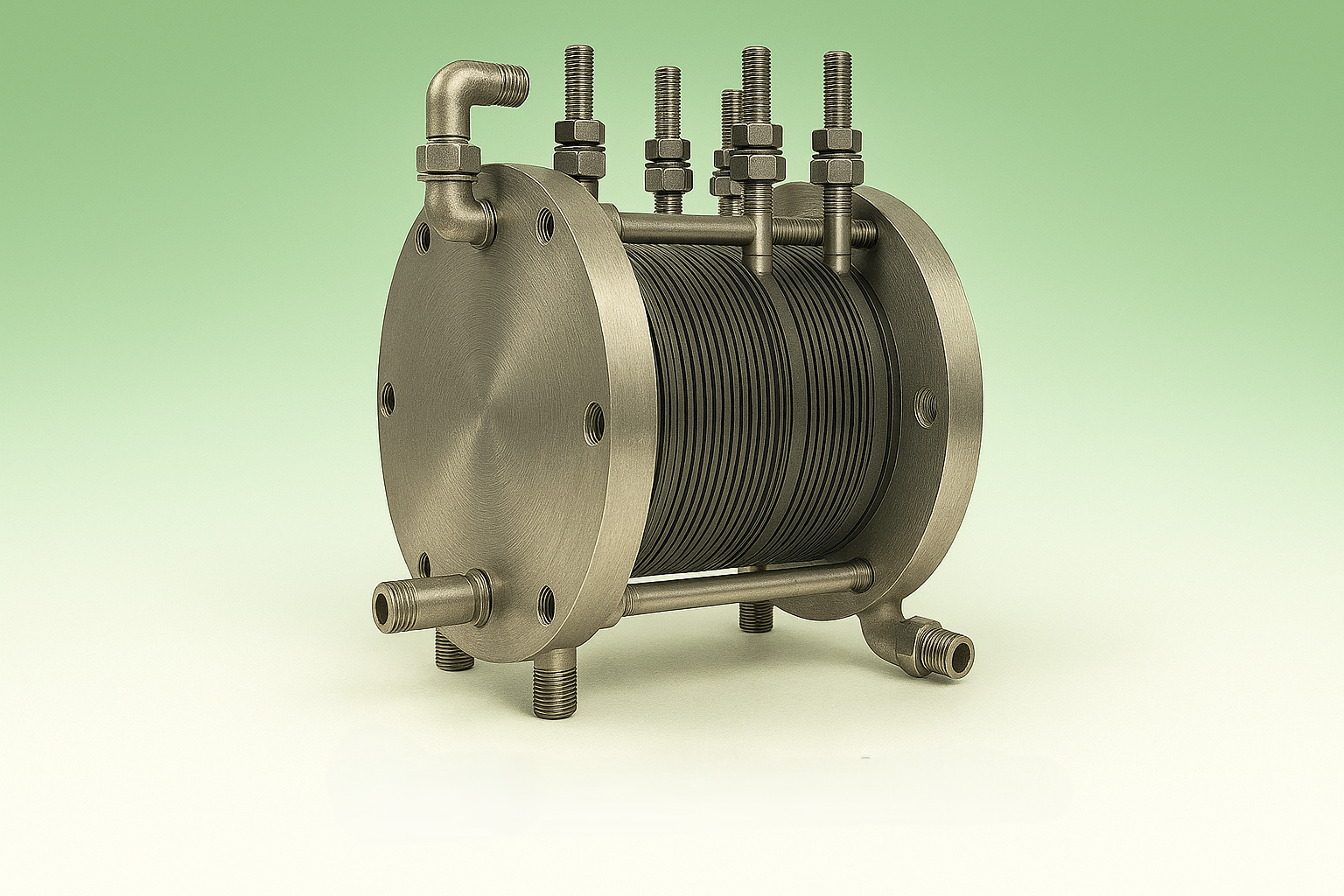ELECTROLYSERS
AEM Electrolyser
Advanced Green Hydrogen
Generation
The Anion Exchange Membrane (AEM) electrolyser is redefining the future of green hydrogen. By allowing negatively charged hydroxyl ions (OH⁻) to move through its membrane while blocking protons (H⁺), our AEM system efficiently produces ultra-pure green hydrogen at the cathode and releases oxygen and water at the anode. This innovative technology combines robust performance with sustainable materials, providing a reliable path to scalable, eco-friendly hydrogen production.

Key Benefits Overview
| Benefit | Description |
|---|---|
| Pressure Output | Delivers up to 30 bar high-pressure hydrogen |
| Hydrogen Purity | Produces 99.9% pure green hydrogen |
| Efficiency | Achieves over 90% operational efficiency |
| Environmental Impact | PFAS-free, enabling sustainable hydrogen production |
PFAS-Free Technology
Our AEM electrolysers are engineered without PFAS, removing a major barrier for the green hydrogen industry. PFAS chemicals are linked to critical health concerns, including increased cancer risk, birth defects, and kidney disorders. By eliminating PFAS, our solution offers a safer, future-proof alternative for clean hydrogen, aligned with the latest global environmental regulations.
Technology Comparison
| Feature | Alkaline | PEM | AEM |
|---|---|---|---|
| Ampacity | Low | High | High |
| Catalyst | PGM Free | PGM Based | PGM Free |
| CAPEX | Low | High | Low |
Regulatory Landscape
Regulatory focus on PFAS has intensified after recent studies showed that over 45% of U.S. tap water is contaminated with these chemicals. As global policies evolve—especially within the EU and US—the hydrogen sector is under greater scrutiny. Our PFAS-free AEM solution ensures compliance, minimizing risk and supporting sustainable hydrogen adoption worldwide.
Proton Exchange Membrane (PEM) Technology
PEM electrolyzers are advanced devices engineered to split water into hydrogen and oxygen, using a specialized proton-conducting membrane. This innovative approach yields clean, high-purity hydrogen, making PEM technology an essential pillar in the transition to a low-carbon energy future.
With rapid response times, compact modular design, and outstanding energy efficiency, PEM electrolyzers adapt seamlessly across industrial, renewable, and distributed energy applications—supporting scalable hydrogen production for tomorrow’s needs.

Advantages of PEM Electrolyzers
| ADVANTAGE | DESCRIPTION |
|---|---|
| High Efficiency | Generates high-purity hydrogen with minimal energy loss. |
| Rapid Startup | Delivers fast cold start and dynamic response for flexible energy management. |
| Compact & Modular | Small footprints and modular units for simple installation and scalable operation. |
| Low Maintenance | Operates safely with only pure water—no hazardous chemicals required. |
Outstanding Efficiency
Engineered for optimal energy conversion and minimal waste.
Pressurized Output
Self-pressurizes hydrogen up to 30 bar—no external compressors needed.
Flexible Scalability
Production from 250 Nm³/h to 1000 Nm³/h and above, thanks to modular design.
Ultra-Pure Hydrogen
Delivers high-purity hydrogen, ready for the most demanding applications.
Easy Integration
Designed for easy installation and rapid deployment, even in space-limited sites.
Streamlined Compliance
Pre-engineered systems help streamline permitting and regulatory approval.
Enabling a Sustainable Hydrogen Future
PEM electrolyzers are at the heart of next-generation clean hydrogen production. Combining efficiency, flexibility, and proven reliability, they empower industries and communities to move forward on the path to a zero-carbon world.
Alkaline Electrolysis (AEL) Technology
Alkaline electrolyzers deliver proven performance for sustainable hydrogen production. With a legacy of nearly a century in the field, this technology remains the foundation for high-volume green hydrogen, particularly when paired with renewable power sources.

How Alkaline Electrolysis Works
AEL systems use a potassium hydroxide (KOH) solution as the electrolyte, with a pair of electrodes separated by a robust diaphragm or membrane. This setup efficiently splits water molecules, producing hydrogen at the cathode and oxygen at the anode via an electrochemical process.
Alkaline Electrolysis Solutions
| SOLUTION COMPONENT | DESCRIPTION |
|---|---|
| Electricity Supply | Electrolysis powered by renewable energy sources |
| Water Purification | Advanced treatment for feedwater quality |
| Hydrogen Production | Purified hydrogen with efficient compression options |
| Integration Capabilities | Ready for carbon capture, e-methanol, hydropower, and more |
100 MW Green Hydrogen Block – Complete EPC Delivery
| SYSTEM COMPONENT | SPECIFICATION |
|---|---|
| Hydrogen Production Capacity | 20,000 Nm3/h |
| Key Systems Included | Water purification, electrolyzer, purification, compression, cooling, MV distribution, AC/DC conversion, automation, and more |
| Civil Construction | Turnkey site development for fast implementation |
Advantages of Alkaline Electrolyzers
| ADVANTAGE | DESCRIPTION |
|---|---|
| Technology Maturity | Decades of proven industrial deployment worldwide |
| Material Composition | Built with widely available materials—no precious metals required |
| Economic Efficiency | Optimized for low capital and operational expenditures at scale |
Future of Green Hydrogen
Alkaline electrolysis remains a cornerstone for the global transition to clean energy. Its scalable and cost-effective design supports rapid expansion of green hydrogen production—driving deep decarbonization for industries worldwide.
Solid Oxide Electrolysis Cells (SOEC)
Solid Oxide Electrolysis Cells (SOEC) are at the forefront of hydrogen production technology, utilizing high temperatures (600–800 °C) to achieve exceptional efficiency. Our advanced, planar electrode-supported SOECs enable efficient hydrogen, syngas, and oxygen production from renewable sources, supporting next-generation industrial decarbonization.

Applications
| APPLICATION AREA | DESCRIPTION |
|---|---|
| Heat and Power Generation | Efficient energy conversion and generation systems |
| Green Hydrogen Production | High-efficiency hydrogen generation from renewable sources |
| Renewable Energy Storage | Advanced storage solutions for intermittent renewable energy |
| Industrial Process Gas | Precision gas production for industrial applications |
| Synthetic Fuels and Chemicals | Production of advanced synthetic fuels and chemical compounds |
Technical Specifications
| PARAMETER | ASC-300C | ASC-400B |
|---|---|---|
| Fuel Contact Layer | NiO | NiO |
| Fuel Electrode Support | NiO/YSZ | NiO/YSZ |
| Electrolyte Composition | YSZ | YSZ |
| Electrolyte Thickness | 3 or 6 µm | 3 or 6 µm |
| Half-Cell Thickness | 300 µm | 400 µm |
| Operating Temperature | 600–800 °C | 600–800 °C |
Benefits of Low Cell Operating Temperature
| BENEFIT | IMPACT |
|---|---|
| Extended Lifetimes | Increased durability and operational longevity |
| Material Cost Reduction | Lower-cost materials for stack and system components |
Future of Electrolysis Technology
Our Solid Oxide Electrolysis Cells (SOEC) set a new benchmark for sustainable hydrogen production and advanced synthetic fuel generation. Leveraging robust design, high-temperature operation, and state-of-the-art materials, our SOECs deliver superior efficiency for both renewable energy integration and industrial-scale projects—empowering the clean energy transition of tomorrow.